Monday, February 25, 2013
Friday, February 15, 2013
SharePoint Server 2013 – User Profile Service Application - 2
This is the second (and last) article in this series. The previous article showed Step 1 of the three step process on how to set up the User Profile Service Application. This article will continue with Step 2 – Testing that the MySite Host has been setup correctly and Step 3 – Configure the User Profile Syndication Service to connect to Active Directory and synchronize user account information into user profiles of the User Profile Service Application. This will complete the setting up of the User Profile Service Application.
Step 2: Testing MySites Host and creating a MySite for the Administrator.
1. Ensure that you are logged into your SharePoint farm with the administrator account, open and internet browser and navigate to the intranet site at http://intranet.ferris.local
2. Look on the top right hand corner and locate the links
- Newsfeed
- SkyDrive
- Sites

3. Click on the Sites link. This link is designed to navigate a user to their MySites page. If the MySite for the user has not yet been created, SharePoint responds by creating a new MySite on demand. Since the MySite for the administrator has not yet been created. Click on the OK button to continue. After the MySite has been provisioned, the following screen pops up

4. This shows that the MySites Host is working. You could go ahead and edit the profile. Note the message that pops up letting you know that the information has been saved and it may take time to show up.

5. After a couple of minutes, refreshing the screen will show the profile.

Step 3: Configuring the User Profile Syndication Service
- Login to the server as the Administrator and press the F8 key to bring up the Start Menu. Click on the Active Directory Users and Groups tile.

2. Add the SP Farm Account to the Administrators Group. If you do not contain AD, request the Administrator to do this for you. You may have to assure the Administrator that you are doing a one way transfer of data only and will not modify AD in any way.

3. Check and see that the account appears as a member of the Administrator’s group. Click OK.

4. Login to the SharePoint server as Administrator, open Central Admin. In the System Settings section, click on Manage Service on Server link to navigate to the Services on Server page. Locate the User Profile Synchronization Service. Note that it displays a Status of Stopped.
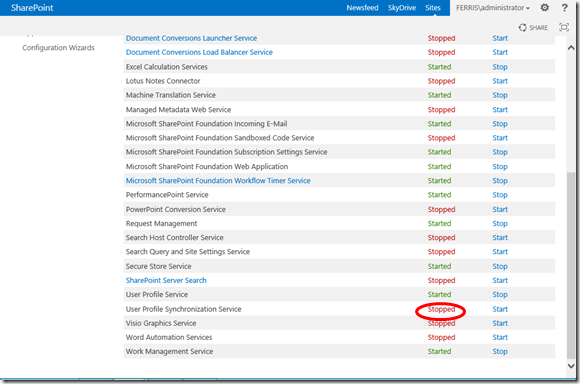
5. Click the Start link to start the User Profile Synchronization Service. SharePoint displays the following page with the farm account already populated. Add the password and click OK.
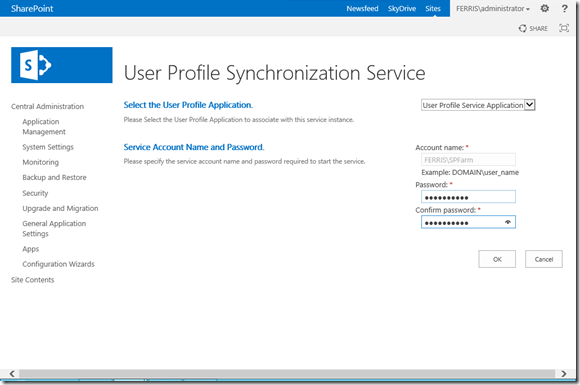
6. You will be returned to the Services on Server page and you will notice that the User Profile Synchronization Service shows a status of Starting.

It is very important to wait until the service starts before proceeding. This takes a very long time to start – about 10 minutes or more.
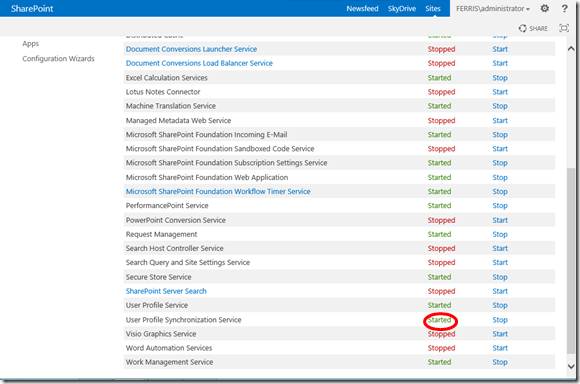
7. Go to the User Profile Service Application Management page. [Aplication Management –> Manage Service Applications –> User Profile Service Application. and click on the service.
Notice on the top right hand that the number of profiles is 1. This is the one created by the administrator when the Administrator MySite was created.
Click on Configure Synchronization Connections.
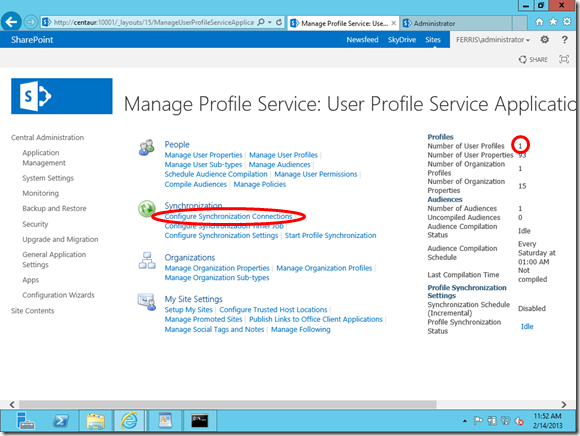
8. A new connection has to be setup. Click in Create a new Connection.
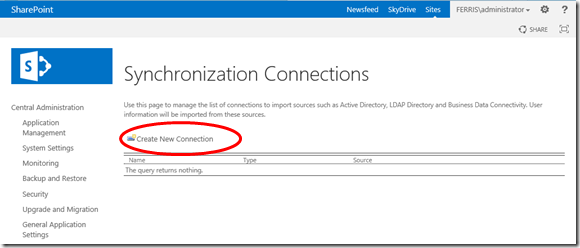
9. Give the connection a name, select the type as Active Directory, specify a domain controlled (this is quicker that using the default of auto discovering a domain controller), put in the forest name, account credentials and scroll further down the page
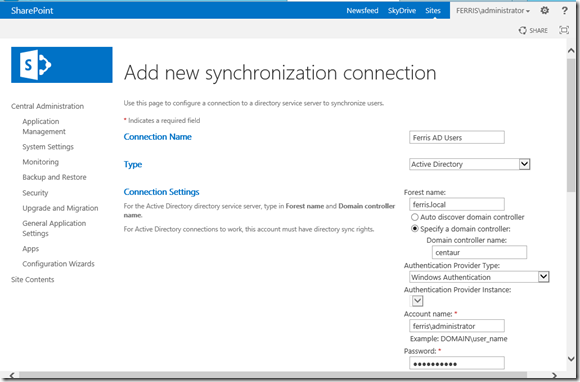
10. Click on Populate Containers and after a short while the AD Forest will appear. Clicking on the + sign will expand the forest. Click on the tree that contains your users. (You need only the users).
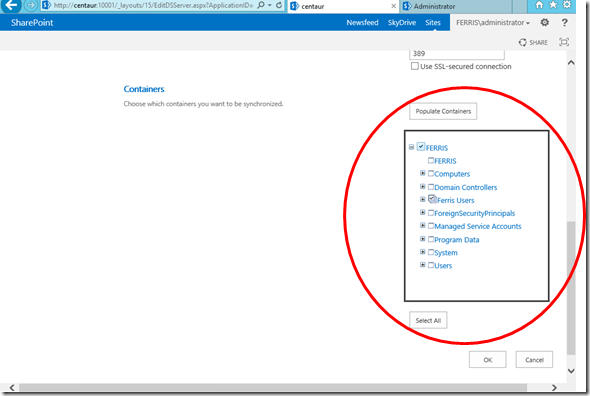
11. Click on OK and the connection will be created as shown below.
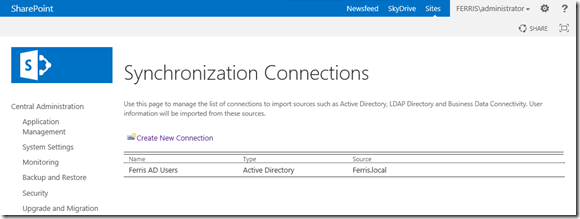
12. Go back to the User Profile Service Application management page. [Application Management –> Manage Service Applications –> User Profile Service Application] and select Start Profile Synchronization
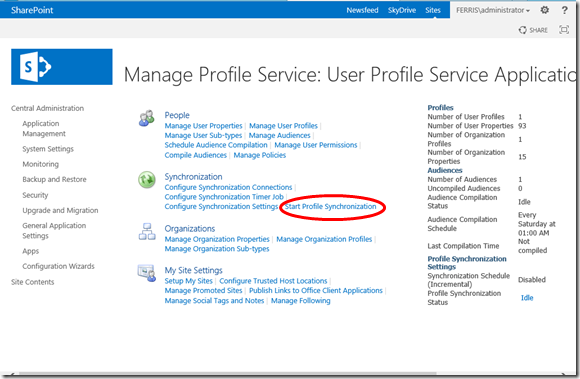
13. Select “Start Full Synchronization and click OK
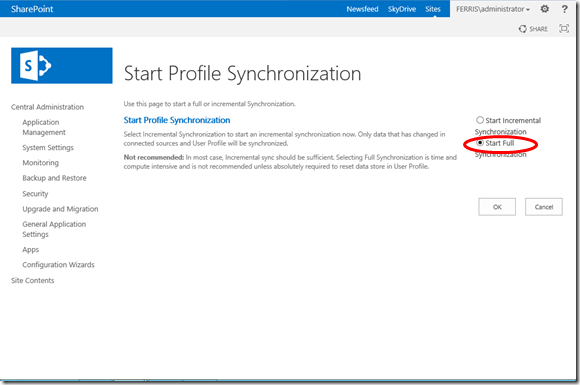
14. The management page appears with the status changed to Synchronizing
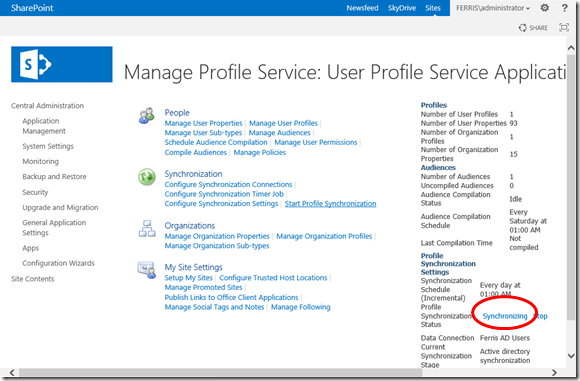
15. When synchronization is complete, the status returns to idle and the number of profiles will reflect the number of users in Active Directory.
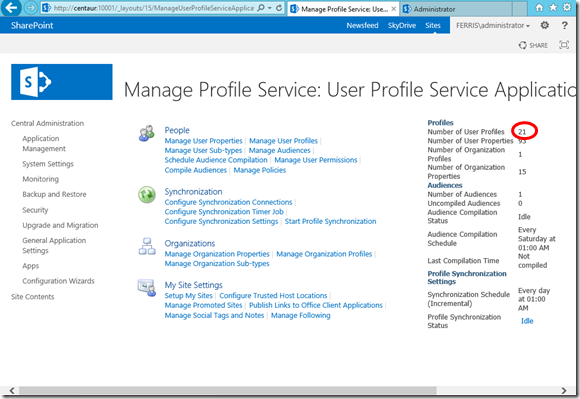
This concludes the successful setup of the User Profile Service Application. Remember to have the Farm Administration account removed from the administrator’s group in AD.
-x-x-x-x
Thursday, February 7, 2013
SharePoint Server 2013 - User Profile Service Application - 1
The User Profile Service Application (UPSA) in SharePoint Server 2013 carries on unchanged from SharePoint Server 2010. This has been one of the real pain points in SharePoint administration, specially the user synchronization setup.. The secret to implementing this application is proper sequencing of events. I will provide a 3 step walk through that will enable you to successfully set this up and get it working at the first attempt every time. (This will work for SharePoint Server 2010 as well).
After installing SharePoint server the administrator is given a choice of using a wizard to configure the service applications. If you use the wizard, uncheck the UPSA and also the Search before proceeding with the wizard. I will provide the methodology of setting up search in a future blog. Even though more time is required, I personally configure all service applications manually because (a) the wizard puts all the service applications into the wrong application pool and (b) a long string of numbers is appended to all the databases in SQL server and I like to give short descriptive names which makes it easy when doing SQL server maintenance tasks.
An assumption is made that you have already created an intranet site.
Step 1: Create the User Profile Service Application. The first requirement is configuring SharePoint to create and host My Sites which will require a new Web Application that is configured for Self Service Site Creation and has a My Site Host site collection.
1. Ensure that you are logged onto a SharePoint server with an administrative account and open Central Administration.
2. Select Application Management -> Manage Web Applications
3. Click on the New button in the ribbon to display the Create New Web Application dialog
4. In the IIS Web Site section in the Create New Web Application Dialog, select the radio button option for Create a new IIS web site and fill in the Name, Port and Host Header. (Information shown is for illustrative purposes. Please your own/your company information) 5. Scroll down to the Public URL section and edit the URL to remove the port number from the end so the URL reads http://mysites.ferris.local. Scroll further down to the Application Pool section, select the button to use an existing application pool and choose Sharepoint – 80, add the SQL server and database name, accept all other defaults and click OK.
5. Scroll down to the Public URL section and edit the URL to remove the port number from the end so the URL reads http://mysites.ferris.local. Scroll further down to the Application Pool section, select the button to use an existing application pool and choose Sharepoint – 80, add the SQL server and database name, accept all other defaults and click OK. 
6. The process to create the new web application will take a few minutes and at the end a dialog box will pop up displaying Application Created and will ask to create a site collection. Click on the Create Site Collection link.
7. Create the My Site Host site collection. On the Create Site Collection page fill in the Title, URL, Template Selection and the Primary Site Collection Administrator
When the site has been created, the Top-Level Site Successfully Created dialog box pops up. There is a link to the new site collection which is inoperable at this time. Click OK to close
The new site My Sites – 80 is in the list of web applications.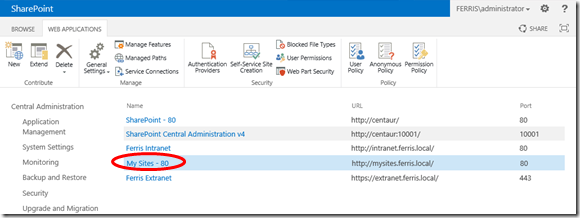
8. Update the new web application to host My Sites. a. Select the My Sites – 80 application, click on the Managed Paths button in the ribbon
b. Remove the sites managed path and add the two new managed paths as shown below
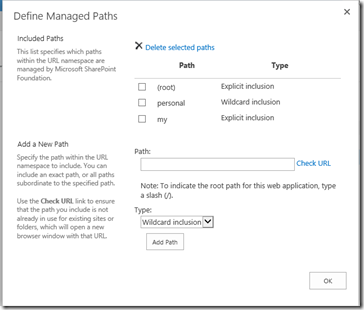
c. With the My Sites – 80 highlighted click on the Self-Service Site Creation button
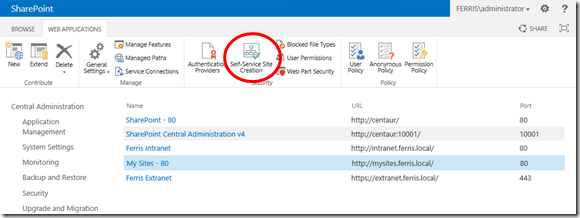
d. On the Self-Service Site Creation Management dialog box click on the On Radio button to enable the option to create Site Collections and then scroll to the bottom of the dialog box and click OK.

The next step is to create an instance of the User Profile Service Application and use the My Site Host to configure the service application.
9. From the home page of Central Administration click Manage Service Applications
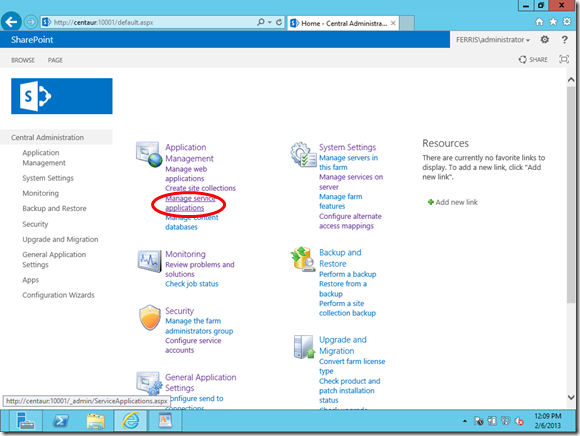
10. In the Service Applications page select the New button and choose User Profile Service Application
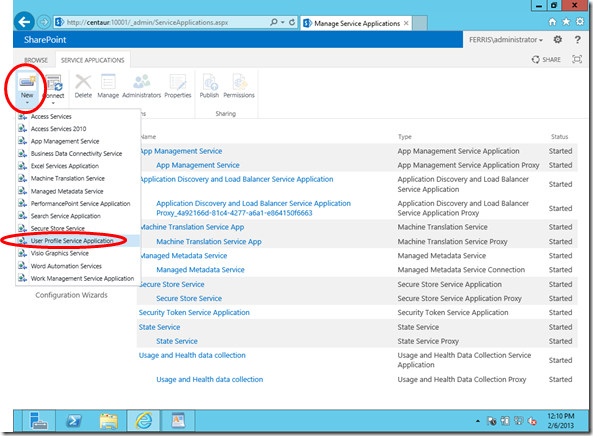
11. In the dialog box that opens, type in the name of the application, use the existing application pool of SharePoint Web Services Default, scroll down and add a URL to the My Site Host URL box, accept the other default settings and click OK to create the new service application. Note that it will take several minutes to create the new service application.
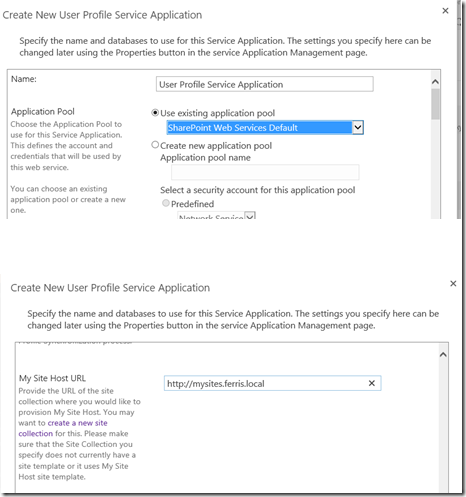
12. When the application is successfully created, SharePoint will display the following dialog box.
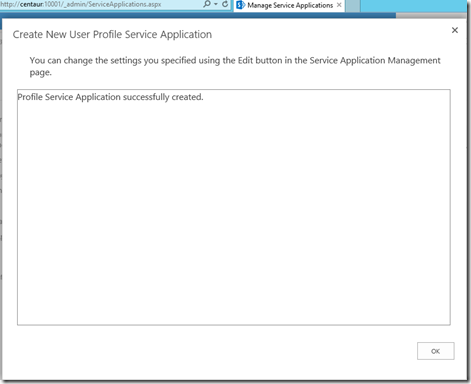
Click OK to close the dialog box.
You have now created and properly configured the user profile service to manage user profiles and create mysites on demand.
Next Steps:
SharePoint Server 2013 - User Profile Service Application - 2
This article will complete setting up User Profile Services in SharePoint 2013
After installing SharePoint server the administrator is given a choice of using a wizard to configure the service applications. If you use the wizard, uncheck the UPSA and also the Search before proceeding with the wizard. I will provide the methodology of setting up search in a future blog. Even though more time is required, I personally configure all service applications manually because (a) the wizard puts all the service applications into the wrong application pool and (b) a long string of numbers is appended to all the databases in SQL server and I like to give short descriptive names which makes it easy when doing SQL server maintenance tasks.
An assumption is made that you have already created an intranet site.
Step 1: Create the User Profile Service Application. The first requirement is configuring SharePoint to create and host My Sites which will require a new Web Application that is configured for Self Service Site Creation and has a My Site Host site collection.
1. Ensure that you are logged onto a SharePoint server with an administrative account and open Central Administration.
2. Select Application Management -> Manage Web Applications

3. Click on the New button in the ribbon to display the Create New Web Application dialog

4. In the IIS Web Site section in the Create New Web Application Dialog, select the radio button option for Create a new IIS web site and fill in the Name, Port and Host Header. (Information shown is for illustrative purposes. Please your own/your company information)
 5. Scroll down to the Public URL section and edit the URL to remove the port number from the end so the URL reads http://mysites.ferris.local. Scroll further down to the Application Pool section, select the button to use an existing application pool and choose Sharepoint – 80, add the SQL server and database name, accept all other defaults and click OK.
5. Scroll down to the Public URL section and edit the URL to remove the port number from the end so the URL reads http://mysites.ferris.local. Scroll further down to the Application Pool section, select the button to use an existing application pool and choose Sharepoint – 80, add the SQL server and database name, accept all other defaults and click OK. 
6. The process to create the new web application will take a few minutes and at the end a dialog box will pop up displaying Application Created and will ask to create a site collection. Click on the Create Site Collection link.

7. Create the My Site Host site collection. On the Create Site Collection page fill in the Title, URL, Template Selection and the Primary Site Collection Administrator

When the site has been created, the Top-Level Site Successfully Created dialog box pops up. There is a link to the new site collection which is inoperable at this time. Click OK to close

The new site My Sites – 80 is in the list of web applications.

8. Update the new web application to host My Sites. a. Select the My Sites – 80 application, click on the Managed Paths button in the ribbon

b. Remove the sites managed path and add the two new managed paths as shown below

c. With the My Sites – 80 highlighted click on the Self-Service Site Creation button

d. On the Self-Service Site Creation Management dialog box click on the On Radio button to enable the option to create Site Collections and then scroll to the bottom of the dialog box and click OK.

The next step is to create an instance of the User Profile Service Application and use the My Site Host to configure the service application.
9. From the home page of Central Administration click Manage Service Applications

10. In the Service Applications page select the New button and choose User Profile Service Application

11. In the dialog box that opens, type in the name of the application, use the existing application pool of SharePoint Web Services Default, scroll down and add a URL to the My Site Host URL box, accept the other default settings and click OK to create the new service application. Note that it will take several minutes to create the new service application.

12. When the application is successfully created, SharePoint will display the following dialog box.

Click OK to close the dialog box.
You have now created and properly configured the user profile service to manage user profiles and create mysites on demand.
Next Steps:
SharePoint Server 2013 - User Profile Service Application - 2
This article will complete setting up User Profile Services in SharePoint 2013
Welcome to my Blog
Information Technology professionals sometimes dive head
first into a challenge without knowing all of their options. Many of us listen to
the requirements then immediately start off on our journey of discovery. Unfortunately there is no such thing as
"quick and easy." For example, the ambitious developer will need a
development environment and possibly even a test and staging environment and
there are often complications that arise from the deployment of the code.
I will highlight in stages some of the new features of
SharePoint 2013, some features that have carried on from previous versions with
all their “features” still in existence and a few infrastructure issues.
Feedback and different solutions that work are welcome.
-
Anil
Subscribe to:
Posts (Atom)